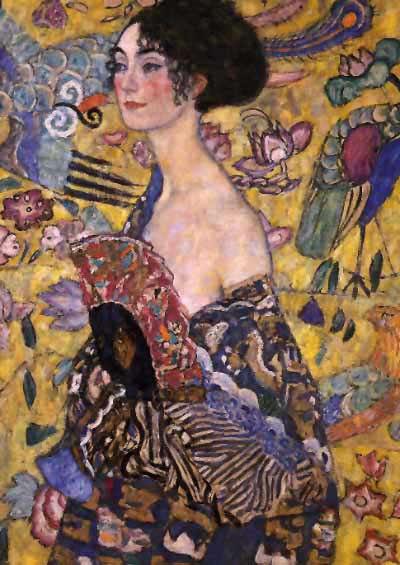Lady with Fan Gustav Klimt (1862-1918)
Gustav Klimt – Lady with Fan
Edit attribution
Download full size: 400×565 px (0,0 Mb)
Painter: Gustav Klimt
Location: Private Collection
Gustav Klimt had the gift of painting from birth, but he did not rely solely on originality and honed his art at the School of Decorative Arts, in Vienna. For a long time his paintings were created in a familiar, academic manner, without giving away the artist’s true predilection for bright, fantastic images and colors. At the end of the XVIII century in the fate of the painter was a series of tragedies - the death of his father, his brother died, and in 1915, Gustav lost his mother.
Description of Gustav Klimt’s painting "Lady with a Fan"
Gustav Klimt had the gift of painting from birth, but he did not rely solely on originality and honed his art at the School of Decorative Arts, in Vienna. For a long time his paintings were created in a familiar, academic manner, without giving away the artist’s true predilection for bright, fantastic images and colors.
At the end of the XVIII century in the fate of the painter was a series of tragedies - the death of his father, his brother died, and in 1915, Gustav lost his mother. This shock was immediately reflected in his paintings - gloomy colors, somber subjects ...
Meeting with Emilia Flege was not only a salvation for Klimt, but also turned his entire oeuvre. There were pictures of luminous love, feminine beauty and charm, sensuality and eroticism.
The Lady with a Fan, painted in 1917-1918, was just such a picture. The Lady is the ideal of a woman who could arouse inspiration, attraction, and awe-inspiring desires in Klimt himself.
Fine noble curves of the body, refined elegance, wisdom and detachment, which can be seen only in the, barely noticeable, smile. The body, naked with a slipped kimono, seems to show the liberated, half-naked soul of an earthly goddess. And this nudity she does not notice, she has nothing to fear, she does not feel sorry for anything, she does not want to hide anything.
The fan that covers her breasts is held by a relaxed hand. The lady is beautiful...and she is not here. Maybe the woman is in her memories, or maybe in her dreams and fantasies, which are magical. Maybe it was these dreams that Klimt displayed as a whimsical backdrop.
Incredible flowers, unseen flowers - this is the world where the enchanting beauty is now.
Not one frank stroke, not one bold moment, only female grace, dignity and beauty, but what eroticism, desirability, the same attraction breathes with the entire canvas.
Кому понравилось
Пожалуйста, подождите
На эту операцию может потребоваться несколько секунд.
Информация появится в новом окне,
если открытие новых окон не запрещено в настройках вашего браузера.
You need to login
Для работы с коллекциями – пожалуйста, войдите в аккаунт (open in new window).




















You cannot comment Why?
In this painting, Lady with Fan, I see a portrait of a woman depicted in a vibrant and richly patterned artistic style. Her head is gently turned to the side, with her gaze directed slightly away from the viewer, lending an air of introspection or perhaps a hint of coyness. She has dark hair styled in a loose, elegant bun, and her skin is rendered with soft hues, contrasted by rosy cheeks.
She is holding a fan, elaborately decorated with colorful patterns, which partially obscures her lower face and décolletage. Her clothing is equally ornate, a flowing garment adorned with intricate designs that merge with the background. The background itself is a tapestry of swirling patterns, floral motifs, and stylized interpretations of birds, possibly peacocks, all rendered in a bold, mosaic-like application of paint. The dominant color palette is warm, with yellows, golds, and oranges, complemented by blues, greens, and reds.
The subtexts of the painting suggest themes of luxury, beauty, and the enigmatic nature of the sitter. The opulent fabrics and the presence of the fan speak to elegance and a certain societal refinement. The directness yet averted gaze of the lady can be interpreted as a subtle power dynamic, where she is observed but maintains a degree of mystery and control over her own presentation. The decorative background, with its rich symbolism of birds (often associated with beauty and immortality) and flowers, enhances the overall sense of aestheticism and perhaps a hint of the exotic or the sensual. The painting invites the viewer to contemplate the womans inner world and her presence within this elaborate, decorative environment.